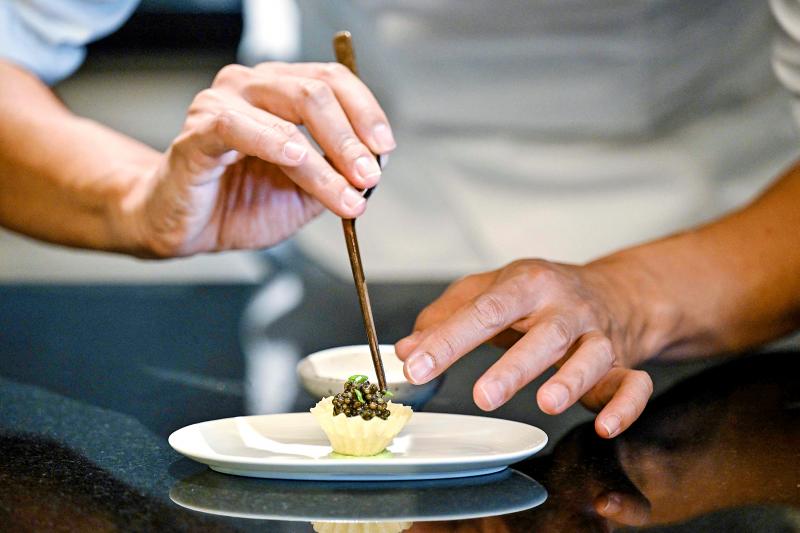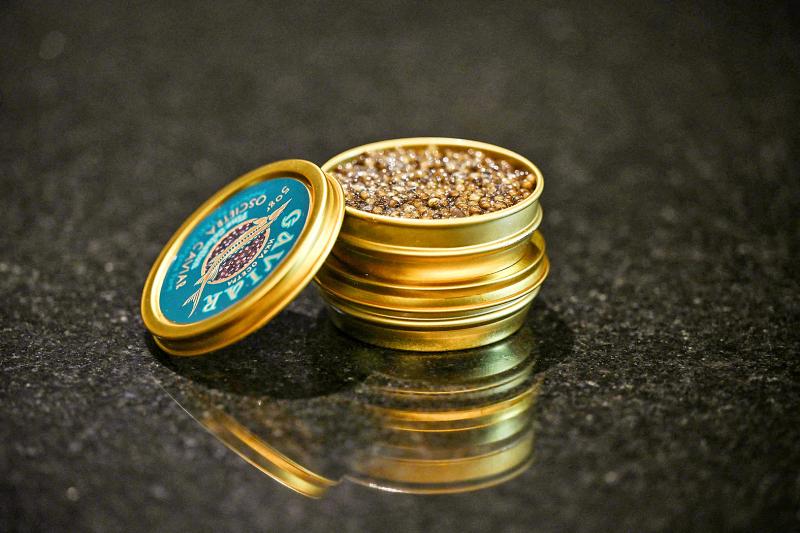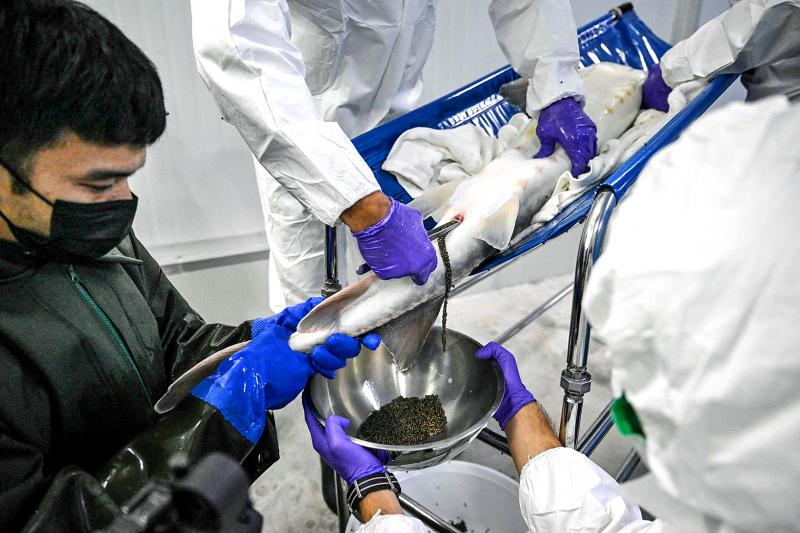At his upmarket Bangkok restaurant, Michelin-starred chef Thitid “Ton” Tassanakajohn spoons black caviar onto a plate, adding the newly affordable Thailand-made delicacy to his reinterpreted traditional family recipes.
The luxury food, better associated with chilly northern nations, is breaking into the Southeast Asian country’s fine-dining scene, with the 37-year-old celebrity cook able to economically serve the roe thanks to an innovative farm outside the capital.
Using high-tech harvesting methods, a Thai-Russian partnership is offering a more ethical and affordable product, sparing the endangered fish that provide the delicacy from their usual fate of death.

Photo: AFP
“The price is... more affordable, I would say, compared to the ones that we imported,” Ton said, as he sprinkled caviar over Thai dip “Lhon Pu” at his restaurant Lahnyai Nusara.
Using caviar also helps challenge perceptions that Thai cuisine must always be spicy with strong flavors, he added.
“I think it’s opened many doors for many chefs to use it as well,” he said.

Photo: AFP
COOL FISH
Roughly 200 kilometers away at the popular seaside resort town of Hua Hin, it is time to harvest “black gold” at the Thai Sturgeon Farm, which supplies local distributor Caviar House.
Hundreds of the giant fish swim in tanks kept at a balmy 21 degrees Celsius — a world away from the chilly Caspian Sea where the species live in the wild.

Photo: AFP
“No one else has this kind of farm in a tropical climate,” the farm’s co-owner Alexey Tyutin said.
The fish — considered living dinosaurs — can survive for up to 100 years and are typically up to four meters long.
Traditionally caviar producers kill the female fish to extract the eggs, but Tyutin’s farm “milks” the sturgeon.

Photo: AFP
Using the fish for as long as possible helps make the venture sustainable and profitable, the 55-year-old said.
During harvesting, fish are moved to the “winter room,” initially set at six degrees Celsius and increased to 15, before their eggs are extracted.
“Let’s say if the fish weighs 25 kilograms, we usually expect about 2.6 to 2.7 kilograms of caviar,” Tyutin said, adding that the farm estimates it may produce up to two tonnes this year.
Breeding sturgeons in a simulated environment requires vast amounts of energy — despite the use of solar panels, the monthly electricity bill is almost US$9,000.
“We are chilling down the water because the water temperature outside is 31 degrees. These fish can’t tolerate it and they will die immediately,” Tyutin said.
But Thailand’s tropical climate has given the business a competitive advantage as the higher water temperature helps sturgeons mature at six years old compared to 11 in Russia.
THAI PRIDE
While Caviar House is only selling domestically at the moment — with a tin of the delicacy retailing for between US$230 and US$832 — they hope to expand to exporting in the future.
Recent European Union sanctions against Moscow over the Ukraine invasion have targeted caviar, but the restrictions are largely symbolic as Russia is only a small exporter.
Instead, competition comes from China, which has become the market giant, producing 84 percent of the world’s sturgeons, according to a European Commission report.
The industry suffered during the pandemic with high-end restaurants, airlines and cruise ships battered by travel curbs, although some fine-dining establishments adapted by decreasing portions and incorporating them into takeaway meals.
But the international caviar market is expected to record a compound annual growth rate of seven percent between 2020 and 2025, according to a report last year by Technavio Research.
France, Germany, China, Spain, the US, Japan and Russia are major markets but demand is fast growing in other parts of the Asia-Pacific region.
Well-heeled Thai foodies and chefs are recognizing the benefits of caviar, rich in vitamins, minerals and omega-3 fatty acids.
“It took only a few days for Thai chefs to start ordering after we sent samples for them to try,” farm co-owner Noppadon Khamsai, 43, said.
“They say this is a good product and the importance is it’s made in Thailand, and they’re really proud to be presenting this Thai product.”

May 18 to May 24 Pastor Yang Hsu’s (楊煦) congregation was shocked upon seeing the land he chose to build his orphanage. It was surrounded by mountains on three sides, and the only way to access it was to cross a river by foot. The soil was poor due to runoff, and large rocks strewn across the plot prevented much from growing. In addition, there was no running water or electricity. But it was all Yang could afford. He and his Indigenous Atayal wife Lin Feng-ying (林鳳英) had already been caring for 24 orphans in their home, and they were in

President William Lai (賴清德) yesterday delivered an address marking the first anniversary of his presidency. In the speech, Lai affirmed Taiwan’s global role in technology, trade and security. He announced economic and national security initiatives, and emphasized democratic values and cross-party cooperation. The following is the full text of his speech: Yesterday, outside of Beida Elementary School in New Taipei City’s Sanxia District (三峽), there was a major traffic accident that, sadly, claimed several lives and resulted in multiple injuries. The Executive Yuan immediately formed a task force, and last night I personally visited the victims in hospital. Central government agencies and the

Australia’s ABC last week published a piece on the recall campaign. The article emphasized the divisions in Taiwanese society and blamed the recall for worsening them. It quotes a supporter of the Taiwan People’s Party (TPP) as saying “I’m 43 years old, born and raised here, and I’ve never seen the country this divided in my entire life.” Apparently, as an adult, she slept through the post-election violence in 2000 and 2004 by the Chinese Nationalist Party (KMT), the veiled coup threats by the military when Chen Shui-bian (陳水扁) became president, the 2006 Red Shirt protests against him ginned up by

As with most of northern Thailand’s Chinese Nationalist Party (KMT) settlements, the village of Arunothai was only given a Thai name once the Thai government began in the 1970s to assert control over the border region and initiate a decades-long process of political integration. The village’s original name, bestowed by its Yunnanese founders when they first settled the valley in the late 1960s, was a Chinese name, Dagudi (大谷地), which literally translates as “a place for threshing rice.” At that time, these village founders did not know how permanent their settlement would be. Most of Arunothai’s first generation were soldiers